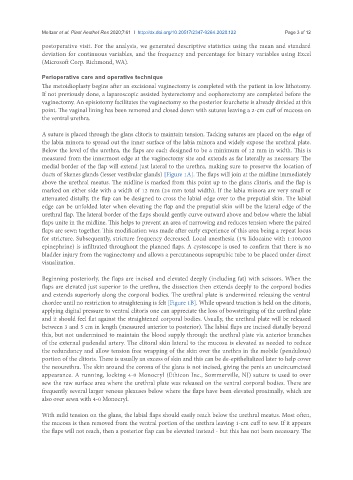Page 715 - Read Online
P. 715
Meltzer et al. Plast Aesthet Res 2020;7:61 I http://dx.doi.org/10.20517/2347-9264.2020.122 Page 3 of 12
postoperative visit. For the analysis, we generated descriptive statistics using the mean and standard
deviation for continuous variables, and the frequency and percentage for binary variables using Excel
(Microsoft Corp. Richmond, WA).
Perioperative care and operative technique
The metoidioplasty begins after an excisional vaginectomy is completed with the patient in low lithotomy.
If not previously done, a laparoscopic assisted hysterectomy and oophorectomy are completed before the
vaginectomy. An episiotomy facilitates the vaginectomy so the posterior fourchette is already divided at this
point. The vaginal lining has been removed and closed down with sutures leaving a 2-cm cuff of mucosa on
the ventral urethra.
A suture is placed through the glans clitoris to maintain tension. Tacking sutures are placed on the edge of
the labia minora to spread out the inner surface of the labia minora and widely expose the urethral plate.
Below the level of the urethra, the flaps are each designed to be a minimum of 12 mm in width. This is
measured from the innermost edge at the vaginectomy site and extends as far laterally as necessary. The
medial border of the flap will extend just lateral to the urethra, making sure to preserve the location of
ducts of Skenes glands (lesser vestibular glands) [Figure 1A]. The flaps will join at the midline immediately
above the urethral meatus. The midline is marked from this point up to the glans clitoris, and the flap is
marked on either side with a width of 12 mm (24 mm total width). If the labia minora are very small or
attenuated distally, the flap can be designed to cross the labial edge over to the preputial skin. The labial
edge can be unfolded later when elevating the flap and the preputial skin will be the lateral edge of the
urethral flap. The lateral border of the flaps should gently curve outward above and below where the labial
flaps unite in the midline. This helps to prevent an area of narrowing and reduces tension where the paired
flaps are sewn together. This modification was made after early experience of this area being a repeat locus
for stricture. Subsequently, stricture frequency decreased. Local anesthesia (1% lidocaine with 1:100,000
epinephrine) is infiltrated throughout the planned flaps. A cystoscope is used to confirm that there is no
bladder injury from the vaginectomy and allows a percutaneous suprapubic tube to be placed under direct
visualization.
Beginning posteriorly, the flaps are incised and elevated deeply (including fat) with scissors. When the
flaps are elevated just superior to the urethra, the dissection then extends deeply to the corporal bodies
and extends superiorly along the corporal bodies. The urethral plate is undermined releasing the ventral
chordee until no restriction to straightening is felt [Figure 1B]. While upward traction is held on the clitoris,
applying digital pressure to ventral clitoris one can appreciate the loss of bowstringing of the urethral plate
and it should feel flat against the straightened corporal bodies. Usually, the urethral plate will be released
between 3 and 5 cm in length (measured anterior to posterior). The labial flaps are incised distally beyond
this, but not undermined to maintain the blood supply through the urethral plate via anterior branches
of the external pudendal artery. The clitoral skin lateral to the mucosa is elevated as needed to reduce
the redundancy and allow tension free wrapping of the skin over the urethra in the mobile (pendulous)
portion of the clitoris. There is usually an excess of skin and this can be de-epithelialized later to help cover
the neourethra. The skin around the corona of the glans is not incised, giving the penis an uncircumcised
appearance. A running, locking 4-0 Monocryl (Ethicon Inc., Sommerville, NJ) suture is used to over
sew the raw surface area where the urethral plate was released on the ventral corporal bodies. There are
frequently several larger venous plexuses below where the flaps have been elevated proximally, which are
also over sewn with 4-0 Monocryl.
With mild tension on the glans, the labial flaps should easily reach below the urethral meatus. Most often,
the mucosa is then removed from the ventral portion of the urethra leaving 1-cm cuff to sew. If it appears
the flaps will not reach, then a posterior flap can be elevated instead - but this has not been necessary. The

